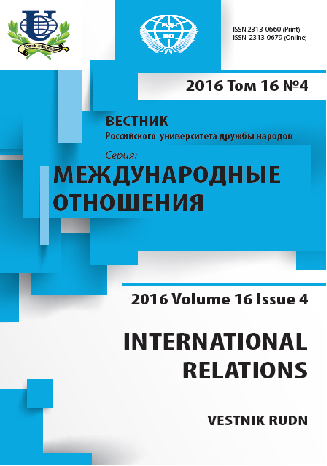Potential role of the NDB and AIIB in the global financial system
- Authors: Larionova M.V.1, Shelepov A.V.1
-
Affiliations:
- Russian Presidential Academy of National Economy and Public Administration
- Issue: Vol 16, No 4 (2016): Iran and India in the System of International Relations
- Pages: 700-716
- Section: Articles
- URL: https://journals.rudn.ru/international-relations/article/view/15443
- DOI: https://doi.org/10.22363/2313-0660-2016-16-4-700-716
Cite item
Full Text
Abstract
This article focuses on the two recently established multilateral development banks (MDBs) dominated by emerging economies: Asian Infrastructure Investment Bank (AIIB) and New Development Bank (NDB). The authors explore the main economic and political incentives that lie behind the creation of these institutions, examine challenges and opportunities they are likely to face, and provide a forecast of their loan portfolios growth in the coming years. The forecast includes two scenarios: basic and optimistic, and is based on the analysis of NDB and AIIB differences from traditional banks, and potential benefits and challenges they can bring. The methodology used for assessment allows projecting the financial capacity of the two banks based on their announced shareholder capital and likely financial performance determined by membership, governance arrangements and other factors, and takes into account recent developments in both banks. Based on the forecast, the authors conclude that in ten years the new banks will be able to provide infrastructure financing at the level of traditional institutions working in the area. In order to develop in accordance with the optimistic scenario, the new banks should adhere to their basic alternative principles, but also rely on the experience of traditional banks in areas where they have proved their effectiveness. These include exchange of experience on selection of projects, social and environmental safeguards, and monitoring results. Apart from addressing the global infrastructure gap, the new banks could also stimulate traditional ones to reform their governance and change operational modalities and thus become more responsive to developing countries’ interests.
About the authors
Marina Vladimirovna Larionova
Russian Presidential Academy of National Economy and Public Administration
Author for correspondence.
Email: larionova-mv@ranepa.ru
Moscow, Russia
Andrei Vladimirovich Shelepov
Russian Presidential Academy of National Economy and Public Administration
Email: shelepov-av@ranepa.ru
Moscow, Russia
References
- Asia Foundation (2016). New Asian Infrastructure and Investment Bank Breaks Ground: What You Need to Know. URL: http://asiafoundation.org/2016/01/27/new-asian-infrastructure-and-investment-bank-breaks-ground-what-you-need-to-know/ (accessed: 05.11.2016).
- Bhattacharya, A., Romani, M. (2013). Meeting the Infrastructure Challenge: The Case for a New Development Bank. Presentation prepared for the G-24 Technical Group Meeting. URL: http://g24.org/wp-content/uploads/2014/03/Session-4_2.pdf (accessed: 05.11.2016).
- European Political Strategy Center (2015). The Asian Infrastructure Investment Bank. A New Multilateral Financial Institution or a Vehicle for China’s Geostrategic Goals. EPSC Strategic Notes, Issue 1, 24 April 2015. URL: http://ec.europa.eu/epsc/pdf/publications/strategic_note_issue_1.pdf (accessed: 05.11.2016).
- Faure, R. et al. (2015). Multilateral development banks: a short guide. ODI. URL: https://www.odi.org/sites/odi.org.uk/files/resource-documents/10650.pdf (accessed: 05.11.2016).
- Global Commission on the Economy and Climate (2016). The Sustainable Infrastructure Imperative. URL: http://newclimateeconomy.report/2016/ (accessed: 05.11.2016).
- Global Commission on the Economy and Climate (2014). Better Growth, Better Climate. URL: http://newclimateeconomy.report/2014/ (accessed: 05.11.2016).
- Griffith-Jones, S. (2011). South-South Financial Cooperation. Background Paper no. 2 to UNCTAD’s Least Developed Countries Report. URL: http://www.stephanygj.net/papers/SOUTHSOUTHFINANCIAL COOPERATION2012.pdf (accessed: 05.11.2016).
- Griffith-Jones, S. (2014). A BRICS Development Bank: a Dream Coming True? UNCTAD Discussion Paper No. 215. March 2014. URL: http://unctad.org/en/PublicationsLibrary/osgdp20141_en.pdf (accessed: 05.11.2016).
- Humphrey, C. (2015a). Challenges and Opportunities for Multilateral Development Banks in 21st Century Infrastructure Finance. The Global Green Growth Institute and the Intergovernmental Group of Twenty Four on Monetary Affairs and Development (G-24). URL: https://www.academia.edu/14934974/Challenges_and_Opportunities_for_Multilateral_Development_Banks_in_21st_Century_Infrastructure_Finance?auto=download (accessed: 05.11.2016).
- Humphrey, C. (2015b). Developmental Revolution or Bretton Woods Revisited? The prospects of the BRICS New Development Bank and the Asian Infrastructure Investment Bank. Overseas Development Institute Working Paper No. 418. Available at: https://www.odi.org/sites/odi.org.uk/files/odi-assets/publications-opinion-files/9615.pdf (accessed: 05.11.2016).
- International Monetary Fund (2016) World Economic Outlook. Too Slow for Too Long. URL: http://www.imf.org/external/pubs/ft/weo/2016/01/pdf/text.pdf (accessed: 05.11.2016).
- Kapur, D., Raychaudhuri, A. (2013). Rethinking the Financial Design of the World Bank. Institute for International Law and Justice. April 2013. URL: http://www.iilj.org/newsandevents/documents/kapur.pdf (accessed: 05.11.2016).
- Lin, J. Y. (2015). “One Belt and One Road” and Free Trade Zones—China’s New Opening-up Initiatives. Frontiers of Economics in China, Vol. 10, Issue 4, pp. 585-590. URL: http://journal.hep.com.cn/fec/EN/abstract/abstract16222.shtml#1 (accessed: 05.11.2016).
- Moody’s (2015). African Development Bank. URL: http://www.afdb.org/fileadmin/uploads/afdb/Documents/Financial-Information/Moodys_Rating_2015.pdf (accessed: 05.11.2016).
- Reisen, H. (2015). Will the AIIB and the NDB Help Reform Multilateral Development Banking? Global Policy, 6(3), pp. 297–304. URL: http://onlinelibrary.wiley.com/doi/10.1111/1758-5899.12250/epdf (accessed: 05.11.2016).
- Standard & Poor's Ratings Services (2014). Global Infrastructure: How to Fill a $500 Billion Hole. URL: http://www.engagedinvestor.co.uk/Journals/2014/01/30/n/a/q/How-To-Fill-A.pdf (accessed: 05.11.2016).
- Ujvari, B. (2016). The European Union and the China-Led Transformation of Global Economic Governance. Egmont Paper 85. URL: http://www.egmontinstitute.be/wp-content/uploads/2016/06/ep85.pdf (accessed: 05.11.2016).
- Wang, H. (2016). New Multilateral Development Banks: Opportunities and Challenges for Global Governance. Part of Discussion Paper Series on Global and Regional Governance of the Council on Foreign Relations. URL: http://i.cfr.org/content/publications/attachments/Discussion_Paper_Wang_MDBs_OR.pdf (accessed: 05.11.2016).











